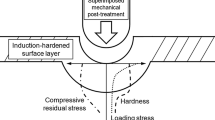Abstract
The susceptibility of 26H2MF and 34HNM structural steels (heat treated to obtain different microstructures) to hydrogen degradation is determined by slow-strain-rate tensile testing at 10−6 sec−1. The parameters such as ultimate strength, elongation to fracture, fracture energy, and reduction in area are evaluated. The substantial degradation of mechanical properties accompanied by brittle fracture is observed in 0.01 M H2SO4 + As2 O3 at a cathodic current density of 20mA/cm2. The degree of degradation of steel is correlated with the modification of microstructure as a result of heat treatment. The observed effects can be attributed to different tendencies of the obtained microstructures to hydrogen trapping.
Similar content being viewed by others
REFERENCES
M. Smialowski, Hydrogen in Steels, Pergamon Press, Oxford (1962).
M. Smialowski, “Initiation of hydrogen-induced cracking in iron and iron alloys,” in: Hydrogen Degradation of Ferrous Alloys, Noyes Publ., Park Ridge (1985), pp. 561–578.
P. Timmins, Solutions to Hydrogen Attack in Steels, ASM, Materials Park (1997).
K. Piotrowski and K. Witkowski, Okretowe Silniki Spalinowe, Trademar, Gdynia (1996).
Klasyfikacja Paliw. Klasyfikacja Paliw Zeglugowych, N-89/C-96800.02.
Paliwa Zeglugowe, PN-93/C-96049.
P. Michalak, “Zmeczeniowe niszczenie instalacji paliwowych silnikow okretowych stymulowane wodorem,” in: Prace Konferencji Mechanika 99, Gdansk (1999), pp. 43–44.
P. Kula, R. Pietrasik, B. Wendler, and K. Jakubowski, “The effect of hydrogen in lubricated frictional couples,” Wear, 212, 199–205 (1997).
P. Michalak and K. Kotkowski, “Hydrogen-enhanced fatigue of fuel installations in diesel engines,” in: Proc. of the Internat. Conf. on the Environmental Degradation of Engineering Materials, Vol. 1, Gdansk-Jurata (1999), pp. 346–350.
P. Michalak and A. Zielinski, “Ocena niebezpieczenstwa kruchosci wodorowej stali stopowych stosowanych na instalacje paliwowe silnikow okretowych,” in: Prace 1 Pomorskiej Konferencji Naukowej Inzynieria Materialowa 2000, Gdansk-Sobieszewo (2000), pp. 161–166.
V. M. A. Devanathan and Z. Stachurski, “The mechanism of hydrogen evolution on iron in acid solution by determination of permeation rates,” J. Electrochem. Soc., 111, 619–627 (1964).
Wodorowe i Korozyjne Niszczenie Metali, PWN, Warszawa (1979).
P. McIntyre, “Hydrogen effects in high strength steels,” in: Hydrogen Degradation of Ferrous Alloys, Noyes Publ., Park Ridge (1985), pp. 763–798.
E. Lunarska,“Effect of hydrogen on the plastic properties of iron single crystals, whiskers, and polycrystals,” in: Hydrogen Degradation of Ferrous Alloys, Noyes Publ., Park Ridge (1985), pp. 321–352.
E. Lunarska,“Hydrogen-induced degradation of low-carbon steel,” in: Hydrogen Degradation of Ferrous Alloy, Noyes Publ., Park Ridge (1985), pp. 712–736.
G.-H. Yu, Y.-H. Cheng, L. Chen, L.-J. Qiao, Y.-B. Wang, and W.-Y. Chu, “Hydrogen accumulation and hydrogen-induced cracking of API tubular steel,” Corrosion, 45, 762–765 (1997).
A. Zielinski and P. Domzalicki, “Hydrogen degradation of high strength low alloyed steels,” in: Proc. of the 7th Internat. Sci. Conf. on the Achievements in Mechanical Materials Engineering, Silesian Univ. Techn., Zakopane (1998), pp. 609–612.
A. Zielinski and P. Domzalicki, “Ocena podatnosci na degradacje srodowiskowa wybranych materialow okretowych,” in: Prace Konferencji Nowe Materialy, Nowe Technologie Materialowe w Przemysle Okretowym i Maszynowym, Szczecin (1998), pp. 253–258.
T. C. Zhang, X. X. Jiang, and S. Z. Li, “Hydrogen-induced embrittlement wear of a high-strength low-alloy steel in an acidic environment,” Corrosion, 45, 200–206 (1997).
A. Zielinski, P. Domzalicki, J. Birn, and C. Poniewierska, “Hydrogen degradation of ship steels,” Marine Techn. Trans., 9, 219–230 (1998).
Fragilisation par l’Hydrogene et Corrosion Sous Contrainte. Phenomenologie et Mecanismes, Edit. Phys., Bombannes (1990), pp. 397–424.
Author information
Authors and Affiliations
Additional information
__________
Published in Fizyko-Khimichna Mekhanika Materialiv, Vol. 40, No. 6, pp. 95–100, November–December, 2004.
Rights and permissions
About this article
Cite this article
Zielinski, A., Lunarska, E., Michalak, P. et al. Strength Deterioration of 26H2MF and 34HNM Steels Used in Ship Engines: Hydrogen Factor. Mater Sci 40, 822–830 (2004). https://doi.org/10.1007/s11003-005-0120-z
Received:
Published:
Issue Date:
DOI: https://doi.org/10.1007/s11003-005-0120-z




